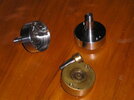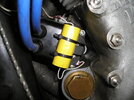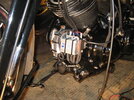I've run a Joe Hunt (rare earth magnet) on my racing outfit for a few seasons and was very pleased with it. My 'rebuilt' Lucas racing magneto stripped its splines and reset the timing at full engine speed which buggered the engine (twisted crank, seized pistons, all the usual). Never again will use the original brass/steel combination. I made up a batch of 20 one piece stainless shafts which were very successful that I advertised in MPH at cost price. Not much interest so that project died. I only use the Lucus mag on my original road bike now.
Regarding Joe Hunt mags I have found there were (are?) three simple issues:
1). The capacitor was of too small a capacity for the high output so I used an external capacitor.
2). The points cam was a few degrees out and needed hand finishing.
3). It needed a propper oil seal fitted.
I believe Joe Hunt has changed hands since I got my mag and these issues have been dealt with. My advice is that if you don't mind the additional bulk, Joe Hunt is a good alternative at a very competitive price.


Regarding Joe Hunt mags I have found there were (are?) three simple issues:
1). The capacitor was of too small a capacity for the high output so I used an external capacitor.
2). The points cam was a few degrees out and needed hand finishing.
3). It needed a propper oil seal fitted.
I believe Joe Hunt has changed hands since I got my mag and these issues have been dealt with. My advice is that if you don't mind the additional bulk, Joe Hunt is a good alternative at a very competitive price.



